

Compact Muon Solenoid
LHC, CERN
| CMS-BPH-22-002 ; CERN-EP-2024-006 | ||
| Observation of the $ \Lambda_{b}^{0}\to\mathrm{J}/\psi\,\Xi^{-}\mathrm{K^+} $ decay | ||
| CMS Collaboration | ||
| 29 January 2024 | ||
| Submitted to Eur. Phys. J. C | ||
| Abstract: Using proton-proton collision data corresponding to an integrated luminosity of 140 fb$ ^{-1} $ collected by the CMS experiment at $ \sqrt{s}= $ 13 TeV, the $ \Lambda_{b}^{0}\to\mathrm{J}/\psi\,\Xi^{-}\mathrm{K^+} $ decay is observed for the first time, with a statistical significance exceeding 5 standard deviations. The relative branching fraction, with respect to the $ \Lambda_{b}^{0}\to\psi(2\mathrm{S})\Lambda $ decay, is measured to be $ \mathcal{B}(\Lambda_{b}^{0}\to\mathrm{J}/\psi\,\Xi^{-}\mathrm{K^+})/\mathcal{B}(\Lambda_{b}^{0}\to\psi(2\mathrm{S})\Lambda) = [ $ 3.38 $ \pm $ 1.02 $ \pm $ 0.61 $ \pm $ 0.03 $ ]$%, where the first uncertainty is statistical, the second is systematic, and the third is related to the uncertainties in $ \mathcal{B}(\psi(2\mathrm{S})\to\mathrm{J}/\psi\,\pi^{+}\pi^{-}) $ and $ \mathcal{B}(\Xi^{-}\to\Lambda\pi^{-}) $. | ||
| Links: e-print arXiv:2401.16303 [hep-ex] (PDF) ; CDS record ; inSPIRE record ; HepData record ; CADI line (restricted) ; | ||
| Figures | |

png pdf |
Figure 1:
Measured $ \psi(2\mathrm{S})\Lambda $ (left) and $ \mathrm{J}/\psi\,\Xi^{-}\mathrm{K^+} $ (right) invariant mass distributions and overlaid fit results. |
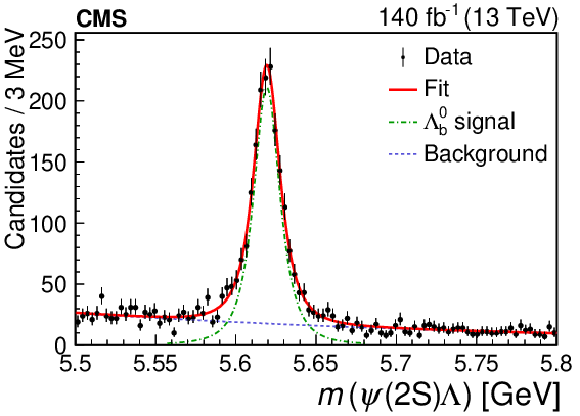
png pdf |
Figure 1-a:
Measured $ \psi(2\mathrm{S})\Lambda $ invariant mass distribution and overlaid fit result. |
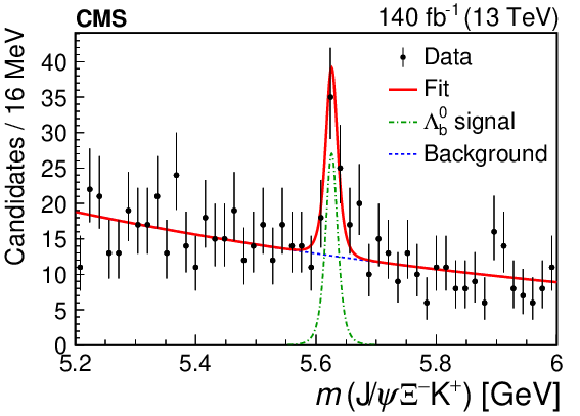
png pdf |
Figure 1-b:
Measured $ \mathrm{J}/\psi\,\Xi^{-}\mathrm{K^+} $ invariant mass distribution and overlaid fit result. |

png pdf |
Figure 2:
Intermediate invariant mass distributions of the $ \Lambda_{b}^{0}\to\mathrm{J}/\psi\,\Xi^{-}\mathrm{K^+} $ decay. The filled circles and empty squares show the measured background-subtracted distributions and the results from the simulation with a phase-space model, respectively. |
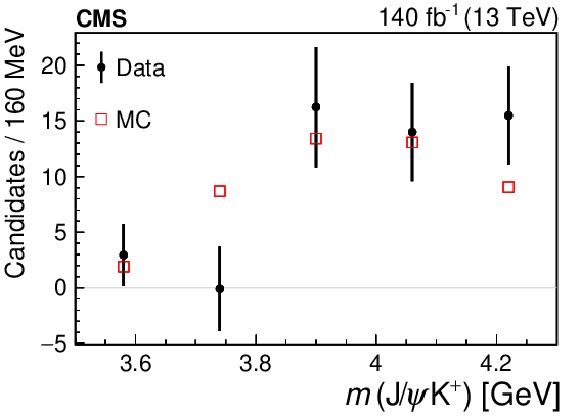
png pdf |
Figure 2-a:
$ \mathrm{J}/\psi\,\mathrm{K^+} $ invariant mass distribution. The filled circles and empty squares show the measured background-subtracted distribution and the results from the simulation with a phase-space model, respectively. |

png pdf |
Figure 2-b:
$ \Xi^{-}\mathrm{K^+} $ invariant mass distribution. The filled circles and empty squares show the measured background-subtracted distribution and the results from the simulation with a phase-space model, respectively. |

png pdf |
Figure 2-c:
$ \mathrm{J}/\psi\,\mathrm{K^+} $ invariant mass distribution. The filled circles and empty squares show the measured background-subtracted distribution and the results from the simulation with a phase-space model, respectively. |
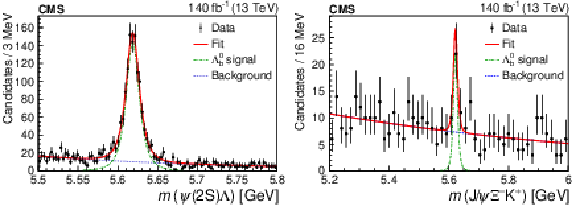
png pdf |
Figure 3:
Measured $ \psi(2\mathrm{S})\Lambda $ (left) and $ \mathrm{J}/\psi\,\Xi^{-}\mathrm{K^+} $ (right) invariant mass distributions and corresponding fits used for the measurement of $ \mathcal{R} $. |
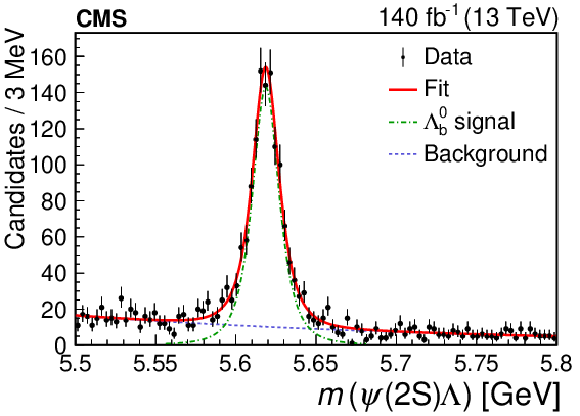
png pdf |
Figure 3-a:
Measured $ \psi(2\mathrm{S})\Lambda $ invariant mass distribution and corresponding fit used for the measurement of $ \mathcal{R} $. |
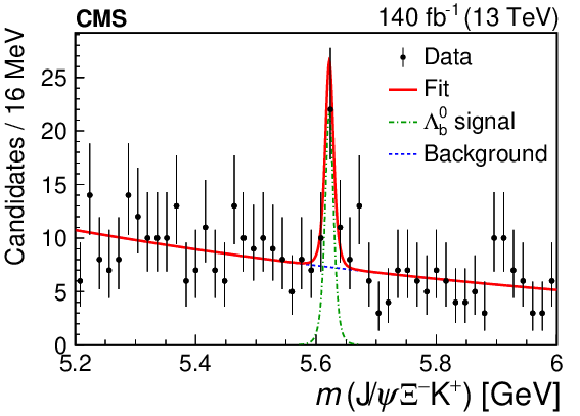
png pdf |
Figure 3-b:
Measured $ \mathrm{J}/\psi\,\Xi^{-}\mathrm{K^+} $ invariant mass distribution and corresponding fit used for the measurement of $ \mathcal{R} $. |

png pdf |
Figure 4:
Measured $ \mathrm{J}/\psi\,\Xi^{-}\mathrm{K^+} $ invariant mass distribution and overlaid constrained fit result. |
| Tables | |
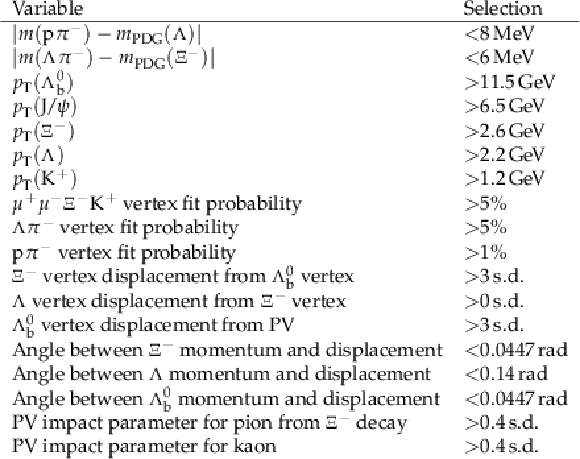
png pdf |
Table 1:
Optimized selection criteria for the signal decay mode $ \Lambda_{b}^{0}\to\mathrm{J}/\psi\,\Xi^{-}\mathrm{K^+} $. The first two requirements are applied using the momenta before the corresponding mass constraint. |

png pdf |
Table 2:
The relative systematic uncertainties in the measurement of $ \mathcal{R} $. |
| Summary |
| The $ \Lambda_{b}^{0}\to\mathrm{J}/\psi\,\Xi^{-}\mathrm{K^+} $ decay is observed with a significance exceeding 5 standard deviations using $ \sqrt{s}= $ 13 TeV proton-proton collision data corresponding to an integrated luminosity of 140 fb$^{-1}$ collected by the CMS experiment. The branching fraction is measured with respect to the $ \Lambda_{b}^{0}\to\psi(2\mathrm{S})\Lambda $ decay to be $ \mathcal{B}(\Lambda_{b}^{0}\to\mathrm{J}/\psi\,\Xi^{-}\mathrm{K^+})/\mathcal{B}(\Lambda_{b}^{0}\to\psi(2\mathrm{S})\Lambda) = [ $ 3.38 $ \pm $ 1.02 (stat) $ \pm $ 0.61 (syst) $ \pm 0.03\,(\mathcal{B})]$%. The distributions of intermediate invariant masses $ m(\mathrm{J}/\psi\,\Xi^{-}) $, $ m(\mathrm{J}/\psi\,\mathrm{K^+}) $, and $ m(\Xi^{-}\mathrm{K^+}) $ from the $ \Lambda_{b}^{0}\to\mathrm{J}/\psi\,\Xi^{-}\mathrm{K^+} $ decay are also presented. This is the first discovered multibody decay containing the $ \mathrm{J}/\psi\,\Xi^{-} $ system, which opens the possibility to search for doubly-strange hidden-charm pentaquarks when more data are collected. The new results are important for understanding the strong interaction processes in hadronic decays of beauty baryons and the possible formation of exotic multiquark states. |
| References | ||||
| 1 | LHCb Collaboration | Observation of $ \mathrm{J}/\psi \mathrm{p} $ resonances consistent with pentaquark states in $ \Lambda_{b}^{0}\to\mathrm{J}/\psi\mathrm{p}\mathrm{K^-} $ decays | PRL 115 (2015) 072001 | 1507.03414 |
| 2 | L. Maiani, A. D. Polosa, and V. Riquer | The new pentaquarks in the diquark model | PLB 749 (2015) 289 | 1507.04980 |
| 3 | E. Santopinto and A. Giachino | Compact pentaquark structures | PRD 96 (2017) 014014 | 1604.03769 |
| 4 | L. Roca, J. Nieves, and E. Oset | LHCb pentaquark as a $ \bar{D}^*\Sigma_c-\bar{D}^*\Sigma_c^* $ molecular state | PRD 92 (2015) 094003 | 1507.04249 |
| 5 | M. I. Eides, V. Y. Petrov, and M. V. Polyakov | Pentaquarks with hidden charm as hadroquarkonia | EPJC 78 (2018) 36 | 1709.09523 |
| 6 | M.-L. Du et al. | Interpretation of the LHCb $ P_c $ states as hadronic molecules and hints of a narrow $ P_c(4380) $ | PRL 124 (2020) 072001 | 1910.11846 |
| 7 | S. X. Nakamura | $ P_c(4312)^+ $, $ P_c(4380)^+ $, and $ P_c(4457)^+ $ as double triangle cusps | PRD 103 (2021) 111503 | 2103.06817 |
| 8 | LHCb Collaboration | Observation of a narrow pentaquark state, $ P_c(4312)^+ $, and of two-peak structure of the $ P_c(4450)^+ $ | PRL 122 (2019) 222001 | 1904.03947 |
| 9 | LHCb Collaboration | Evidence of a $ \mathrm{J}/\psi\Lambda $ structure and observation of excited $ \Xi^{-} $ states in the $ \Xi_{b}^{-} \to \mathrm{J}/\psi\Lambda \mathrm{K^-} $ decay | Sci. Bull. 66 (2021) 1278 | 2012.10380 |
| 10 | LHCb Collaboration | Evidence for a new structure in the $ \mathrm{J}/\psi\mathrm{p} $ and $ \mathrm{J}/\psi\overline{\mathrm{p}} $ systems in $ \mathrm{B}_{s}^{0}\to\mathrm{J}/\psi\mathrm{p}\overline{\mathrm{p}} $ decays | PRL 128 (2022) 062001 | 2108.04720 |
| 11 | LHCb Collaboration | Observation of a $ \mathrm{J}/\psi\Lambda $ resonance consistent with a strange pentaquark candidate in $ {\mathrm{B}^{-}}\to \mathrm{J}/\psi\Lambda\bar{p} $ decays | PRL 131 (2023) 031901 | 2210.10346 |
| 12 | K. Azizi, Y. Sarac, and H. Sundu | Investigation of hidden-charm double strange pentaquark candidate $ P_{css} $ via its mass and strong decays | EPJC 82 (2022) 543 | 2112.15543 |
| 13 | F.-L. Wang, X.-D. Yang, R. Chen, and X. Liu | Hidden-charm pentaquarks with triple strangeness due to the $ \Omega_{c}^{(*)}\bar{D}_s^{(*)} $ interactions | PRD 103 (2021) 054025 | 2101.11200 |
| 14 | CMS Collaboration | Precision luminosity measurement in proton-proton collisions at $ \sqrt{s} = $ 13 TeV in 2015 and 2016 at CMS | EPJC 81 (2021) 800 | CMS-LUM-17-003 2104.01927 |
| 15 | CMS Collaboration | CMS luminosity measurement for the 2017 data-taking period at $ \sqrt{s} = $ 13 TeV | CMS Physics Analysis Summary, 2018 CMS-PAS-LUM-17-004 |
CMS-PAS-LUM-17-004 |
| 16 | CMS Collaboration | CMS luminosity measurement for the 2018 data-taking period at $ \sqrt{s} = $ 13 TeV | CMS Physics Analysis Summary, 2019 CMS-PAS-LUM-18-002 |
CMS-PAS-LUM-18-002 |
| 17 | CMS Collaboration | HEPData record for this analysis | link | |
| 18 | CMS Collaboration | The CMS experiment at the CERN LHC | JINST 3 (2008) S08004 | |
| 19 | CMS Collaboration | Description and performance of track and primary-vertex reconstruction with the CMS tracker | JINST 9 (2014) P10009 | CMS-TRK-11-001 1405.6569 |
| 20 | CMS Tracker Collaboration | The CMS Phase-1 pixel detector upgrade | JINST 16 (2021) P02027 | 2012.14304 |
| 21 | CMS Collaboration | Track impact parameter resolution for the full pseudo rapidity coverage in the 2017 dataset with the CMS Phase-1 pixel detector | CMS Detector Performance Note CMS-DP-2020-049, 2020 CDS |
|
| 22 | CMS Collaboration | The CMS trigger system | JINST 12 (2017) P01020 | CMS-TRG-12-001 1609.02366 |
| 23 | CMS Collaboration | Performance of the CMS Level-1 trigger in proton-proton collisions at $ \sqrt{s} = $ 13\,TeV | JINST 15 (2020) P10017 | CMS-TRG-17-001 2006.10165 |
| 24 | T. Sjöstrand et al. | An introduction to PYTHIA 8.2 | Comput. Phys. Commun. 191 (2015) 159 | 1410.3012 |
| 25 | CMS Collaboration | Extraction and validation of a new set of CMS PYTHIA8 tunes from underlying-event measurements | EPJC 80 (2020) 4 | CMS-GEN-17-001 1903.12179 |
| 26 | D. J. Lange | The EvtGen particle decay simulation package | NIM A 462 (2001) 152 | |
| 27 | E. Barberio and Z. Was | PHOTOS --- a universal Monte Carlo for QED radiative corrections: version 2.0 | Comput. Phys. Commun. 79 (1994) 291 | |
| 28 | GEANT4 Collaboration | GEANT 4 --- a simulation toolkit | NIM A 506 (2003) 250 | |
| 29 | CMS Collaboration | Performance of the CMS muon detector and muon reconstruction with proton-proton collisions at $ \sqrt{s}= $ 13 TeV | JINST 13 (2018) P06015 | CMS-MUO-16-001 1804.04528 |
| 30 | CMS Collaboration | CMS tracking performance results from early LHC operation | EPJC 70 (2010) 1165 | CMS-TRK-10-001 1007.1988 |
| 31 | Particle Data Group Collaboration | Review of particle physics | Prog. Theor. Exp. Phys. 2022 (2022) 083C01 | |
| 32 | G. Punzi | Sensitivity of searches for new signals and its optimization | in Proceedings of PHYSTAT 2003, Statistical problems in particle physics, astrophysics and cosmology | physics/0308063 |
| 33 | S. Jackman | Bayesian analysis for the social sciences | John Wiley & Sons, New Jersey, USA, 2009 link |
|
| 34 | S. S. Wilks | The large-sample distribution of the likelihood ratio for testing composite hypotheses | Annals Math. Statist. 9 (1938) 60 | |
| 35 | G. Cowan, K. Cranmer, E. Gross, and O. Vitells | Asymptotic formulae for likelihood-based tests of new physics | EPJC 71 (2011) 1554 | 1007.1727 |
| 36 | N. L. Johnson | Systems of frequency curves generated by methods of translation | Biometrika 36 (1949) 149 | |
| 37 | M. Pivk and F. R. Le Diberder | $ _\mathrm{{s}}\mathcal{P}\mathrm{lot} $: a statistical tool to unfold data distributions | NIM A 555 (2005) 356 | physics/0402083 |
| 38 | CMS Collaboration | Tracking performances for charged pions with Run2 legacy data | CMS Detector Performance Note CMS-DP-2022-012, 2022 CDS |
|
| 39 | CMS Collaboration | Observation of a new excited beauty strange baryon decaying to $ \Xi_{b}^{-}\pi^{+}\pi^{-} $ | PRL 126 (2021) 252003 | CMS-BPH-20-004 2102.04524 |
| 40 | CMS Collaboration | Study of excited $ \Lambda_\mathrm{b}^0 $ states decaying to $ \Lambda_\mathrm{b}^0\pi^+\pi^- $ in proton-proton collisions at $ \sqrt{s}= $ 13 TeV | PLB 803 (2020) 135345 | CMS-BPH-19-003 2001.06533 |

|
Compact Muon Solenoid LHC, CERN |

|

|

|

|

|

|